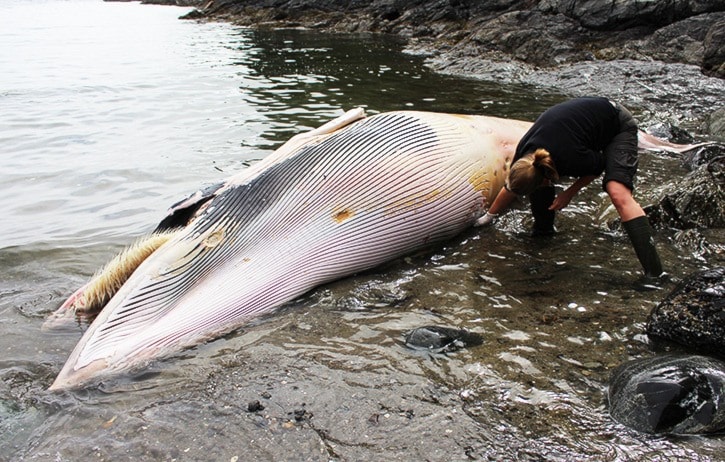Some blessings are heavily disguised.
Two whales that recently washed up on the West Coast could become educational goldmines thanks to the locals who reported them fast enough for fresh samples to be taken.
A juvenile grey whale carcass was found at the Wya Point Resort near Ucluelet on March 29 and a baby minke whale carcass was discovered in Ucluelet’s Spring Cove on April 6.
The minke was reported by area resident Ellen Kimoto and local marine mammal expert Wendy Szaniszlo arrived quickly to investigate. Szaniszlo said the roughly four-metre-long animal was less than one-year-old and, based on its decomposition, had likely been dead for about a week before washing ashore.
The Department of Fisheries and Oceans Canada has taken samples from both whales in an effort to figure out how they died, according to DFO marine mammal coordinator Paul Cottrell.
“It’s always a concern when you have two whales die so close together near the same time so we’re going to be analyzing those samples to see what we can find out,” Cottrell told the Westerly.
“Anytime we get a dead cetacean we want to look at cause of death. We want to determine if there was any human influence, like vessel strike or some other issue, and we also want to know the reason that it died if it’s not to do with a human cause.”
He noted harmful algal blooms proved hazardous to local marine life last year.
“That may be an issue this year so we’re testing for that to see if there’s any harmful algal bloom influence on why the animals would have died,” he said.
“We want to look at any potential relationship between the two deaths and harmful algal blooms are something that we’re monitoring…If there is anything to do with a biotoxin issue, we want to know because that could impact other whales in the area.”
He added the young grey whale would have been migrating to its feeding grounds in the Arctic.
“Sometimes, animals don’t fatten up enough and they do drop out of the population during their migration back to the feeding grounds,” he said. “We do get grey whales that die this time of year typically.”
Minke whales are small baleen whales abundant in local waters. They follow less predictable migration patterns than greys and little is known about their reproductive cycles other than they typically wean their young early.
Cottrell was thrilled that locals reported both whale carcasses immediately.
“The eyes and ears in both Tofino and Ucluelet are amazing and often, with marine mammals coming ashore, we get a very quick response,” he said.
“We’re doing our best to collect the key samples to see what may have caused the death of these animals. Often you can’t determine cause of death…but we’re hoping we can at least rule certain things out for sure.”
He said it is vital for locals to report their sightings of dead or distressed marine mammals to DFO’s 24-hour marine mammal response line at 1-800-465-4336.
“The quicker we know about it the quicker we can act and the fresher the sample is, for example if it is a dead marine mammal then the better information we can get from that carcass,” he said.
Ucluelet Aquarium curator Laura Griffith-Cochrane told the Westerly it’s important to wait for DFO’s necropsy results before speculating on either whale’s death.
“There’s always reason to be concerned in that we should look into it and figure out the reason behind it but, it’s also important not to jump to conclusions,” she said. “We don’t know yet why both of those whales have died.”
She noted both whales were young when they washed up.
“There’s a higher mortality rates when they’re very young or very old,” she said. “When these young whales are going through their big migrations, that’s the riskiest time for them; they’re most susceptible to starvation or predation.”
Whale carcasses are treasure chests full of valuable learning tools that can help infuse perspective into oceanic educations and Griffith-Cochrane noted that, thanks to a valuable partnership with the Royal BC Museum, Ukee’s aquarium scored a piece of baleen from a grey whale that washed up on Wickaninnish Beach last year.
“Marine education is so important but it’s hard to educate people without a reference,” she said. “Whales are a big part of the coast, it’s a big part of our economy…There’s something about whales that really awes people.”
